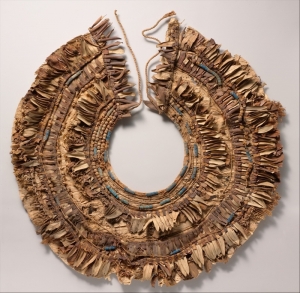Other early pieces come from excavations in China. Currently the earliest surviving example of embroidery discovered from this vast country comes from a tomb in Mashan, in Hubei province, which dates to the Zhanguo period (5th -3rd centuries BC). This example is made with silk yarns on a silk ground. Silk embroidered textiles were also found in the salt mines of Hallstatt, Austria, that date back to 500 BC. The silk came from unravelled Chinese textiles that had somehow found their way to Europe. Woollen embroideries were discovered at the Hallstatt site of Hohmichelle, also dating to about 500 BC.
Examples of embroidery from the first century AD onwards come in many varied and different forms from around the world, such as the embroidered clothing wrapped around mummies from Peru, Coptic pieces from Egypt, as well as fragments of embroidery from various sites in Central Asia, such as Dunhuang, Niya and Lou-Lan. Byzantine and early Russian embroideries have survived in the Catherine Monastery collection, southern Sinai, Egypt.
A wide range of Chinese, Indian and Japanese embroideries has survived in the Shoso-in, Todai-ji temple complex at Nara, Japan, which was founded in the eighth century AD (click here). Occasionally groups of early medieval embroideries have survived in Europe, such as in the Viking tomb of a man from Mammen, Denmark, which dates to the tenth century AD. On other occasions it is one, huge embroidery such as the famous Bayeux tapestry, which depicts the invasion of England by William the Conqueror in 1066.
From the twelfth century AD onwards, the range of surviving embroideries increases considerably, and there are many collections throughout the world that include medieval and later examples of embroidery.
Metropolitan Museum of Art online catalogue (retrieved 9th July 2016).
GVE

